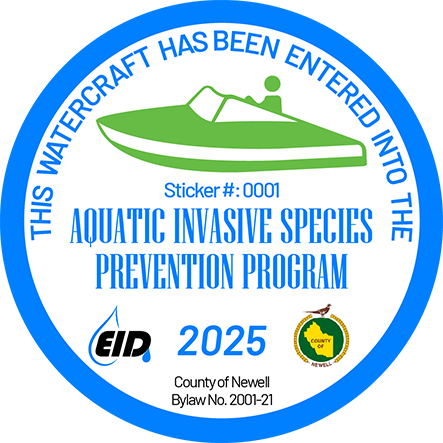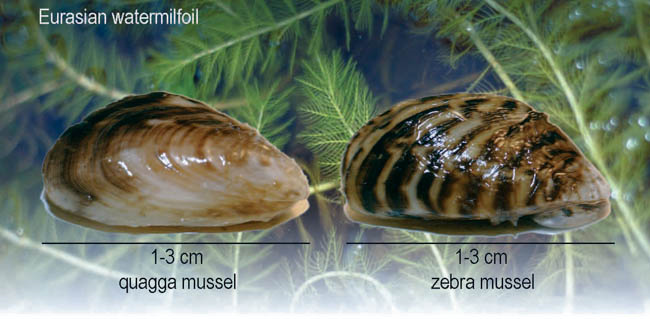Aquatic invasive species (AIS) like zebra and quagga mussels pose a serious threat to Alberta’s water infrastructure, ecosystems, and economy. To help prevent their introduction into Alberta, the EID initiated an AIS Prevention Program in 2018. All watercraft users accessing EID reservoirs must follow approved prevention procedures and receive a new sticker each year prior to launching. Watercraft includes both motorized and non-motorized vessels such as kayaks, paddleboards, and canoes. Trailered watercraft are only permitted to launch from designated boat launches and must check-in before launching. Non-trailered watercraft (canoes, kayaks, paddleboards, etc.) may launch at other locations, but must still check-in before launching.
Failure to comply with AIS protocols may result in loss of access to EID lands and reservoirs. This program is supported by the County of Newell’s Boating Safety and Aquatic Invasive Species Bylaw (2001-21).
Please remember to clean, drain, and dry your watercraft before moving to a new waterbody. Do not release garden plants or pets into the wild.
Click here to download the AIS Quick Fact Card .
Please see below for information on Aquatic Invasive Species.


The Eastern Irrigation District is collaborating with other irrigation districts and the Government of Alberta in support of the fight against the introduction and establishment of aquatic invasive species into Alberta’s waterbodies.
The 11 irrigation districts, all located in southern Alberta, including the Eastern Irrigation District are especially concerned with Zebra and Quagga mussels and have collaborated on several projects to prevent the establishment of mussels in Alberta. Through the Alberta Irrigation Districts Association (AIDA) a trial Mussel Dog Detector Inspection Program was brought to Alberta in the spring of 2014/2015. Dogs trained to target mussels by scent were deployed at Alberta commercial vehicle inspection stations (VIS) to efficiently and effectively search for mussel infestation on high-risk watercraft travelling into Alberta.
The program proved such a success that in 2015 the Eastern, Bow River, Taber, Lethbridge Northern, Raymond, United, and Western irrigation districts funded the training of four Mussel Detection Dog teams for permanent deployment within the Province’s AIS Inspection Program. In March 2015, the Government of Alberta announced mandatory inspection of all trailered watercraft entering Alberta from any other province or state with AIS Inspection Stations established at most Alberta commercial vehicle inspection stations.
An invasive species is an organism not native to an area or ecosystem which when introduced establishes readily and alters the ecosystem, almost always with negative results, and are almost impossible to eradicate.
Aquatic invasive species are extremely detrimental to Alberta irrigation because they will:
Most aquatic invasive species are introduced and spread from one waterbody to another through transportation of infested trailered watercraft. Some aquatic invasive species may also be introduced into waterbodies through intentional dumping of fish and/or aquatic plants from household aquariums or backyard ponds. Zebra mussels (Dreissena polymorpha), Quagga mussels (Dreissena rostiformis bugensis), Flowering Rush (Butomus umbellatus), and Prussian Carp (Carassius gibelio) are aquatic invasive species of most concern in Southern Alberta.
What can YOU do to prevent the establishment and spread of aquatic invasive species into Alberta’s waterbodies?
Though not currently present in Alberta waterbodies, Zebra and Quagga mussels are of particular concern for a number of reasons. Most of Alberta’s waterbodies are considered high risk for Zebra and Quagga mussel establishment as the chemical and physical properties of Alberta’s waterbodies are favourable habitat for these mussels. If introduced, mussels will establish rapidly and quickly change the ecosystem by competing with native organisms for food and developing large, sessile colonies. These effects will be devastating to the ecology and recreational enjoyment of Alberta’s waterbodies.
Due to their physiology, mussels are small and can attach to numerous small crevices and cracks found within watercraft and because of this are sometimes not visible upon observation. Adult mussels can survive up to 30 days out water, given the right temperature and humidity levels, and the microscopic larvae of mussels (veligers) can survive within water in bilges and live wells for a number of days. Given this, it is easy to see that an infected boat transported to a different waterbody may easily infect the new waterbody without the owner’s realization.